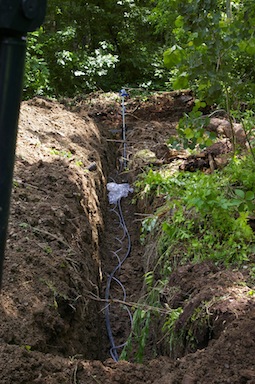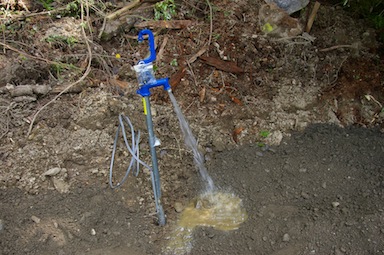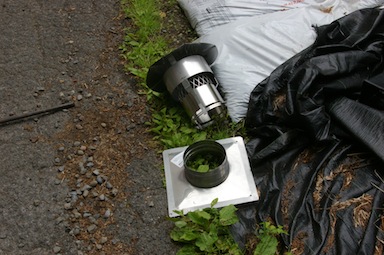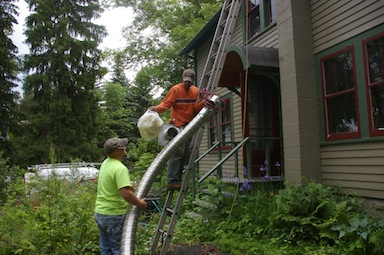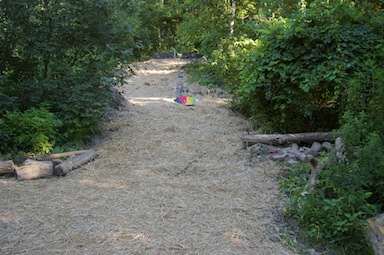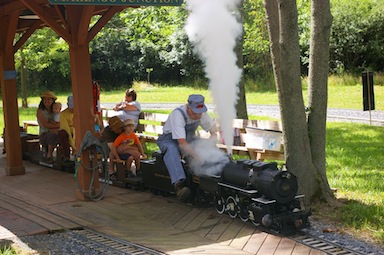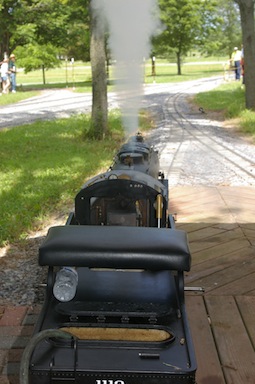June 5, 2012
Energy infrastructure takes time to shift
I had an exchange this morning on the Sustainable Tompkins mailing list that seems worth reprinting here.
On 6/5/12 8:31 AM, George Frantz wrote:
More importantly than the question of indigestion, in my opinion, is the question of will this current crisis will ever change the fact that 6 out of 10 homes here in Tompkins County, all of our major employers, and most of the stores we shop in, are heated with natural gas.
When are we going to stop paying our Big Energy surrogates to rape the environments of other regions of the world for our energy supplies?
While I would like to pay Big Energy much less, the actual story isn't anywhere near that simple.
Until about a decade ago, natural gas was pretty much the least intrusive form of energy extraction. Yes, there were pipelines, and yes, it was the cause of some horrible accidents, but the actual extraction was less damaging than oil or coal.
I grew up in a city (Corning) that thrived thanks to its being near first coal and then natural gas sources, combined with the silica from Pennsylvania that made great glass. We didn't just have natural gas infrastructure - we had our own gas company, separate from NYSEG, that benefited the city because of the massive purchases of natural gas for glassmaking.
My senior prom date had a gas well on her farm, about 100 yards across the road. I remembered it being a tiny (if very profitable) thing, and had to go check last year when I was in the area. It's still there, and still tiny.
Most of the infrastructure you grouse about here was installed in a time when natural gas was indeed a clean(er) fuel, filling a niche for home heating and other heat-intensive uses. I marvel at the industry spokespeople who think "Nyah, nyah, your house is heated with gas so shut up" is an argument.
I'm doing what I can to reduce my contributions to the extractive energy crowd. Almost a decade ago I replaced my furnace and insulated my house, and cut my natural gas consumption by about 3/5. I added an on-demand water heater and cut my consumption further. Yes, I added a gas cooktop, though except perhaps in canning season that's not a huge consumer.
All of that was about reducing energy consumption generally, though, not migrating from natural gas, because at that point there was little sign that natural gas would be especially damaging to the world.
This year's project goes a lot further - we're installing a woodstove that can heat the house, cook and bake food, and provide hot water. It will substantially reduce our use of gas and electricity, and also let us worry less about the potential impact of an extended power outage. (No electricity, no furnace.)
You can see the start of that work at:
<https://livingindryden.org/2012/05/woodstove_part_i.html>I'm happy about this work, but I also look at the costs, comparable options for those without a woodlot behind the house, the many renters with little control over their heat options, and the general difficulties of changing infrastructure, and my rhetoric ends up a lot calmer than George's.
Infrastructure changes are never easy. We build things at one time thinking they're both convenient and environmentally sound, and later the rules change.
The rules could change in a worse way, of course, as I suspect owners of gas wells in Seneca and Cayuga counties are about to learn:
<http://tomwilber.blogspot.com/2012/06/pa-company-targets-utica-shale-in.html>So yes, let's pay the extractive industry folks a lot less by using less of what they're selling. We also need to accept that it's going to take a while, and not spend that while thrashing ourselves because circumstances changed.
June 11, 2012
Nodal development apparently still the hot planning buzzword here
I'm a little confused. A fair amount of the private response I got back on my nodal development critique last year was that Tompkins County wasn't as excited about that particular phrase any longer and I was shooting at something that didn't really matter.
I guess not, though - or maybe the Ithaca Journal didn't get that memo? An article headlined Tompkins planners strategize for conservation, nodal development reports:
As for development, specific strategies include promoting nodal designs fitting established communities, improving water and sewer systems, and providing pedestrian and bicycle facilities within nodes and transit connections between nodes.
Hmm... sounds about the same as it's been. I guess I'll have to go check out their meeting at the Varna Community Center (943 Dryden Road) on June 18th at 6:30pm. Update: Nope, can't make it. Maybe I'll get to a later meeting.
On the bright side, I guess this means that the nodal development category here is still useful.
June 13, 2012
Looks like Home Rule may be the answer on drilling
This sounds like a trial balloon to me:
Cuomo Plan Would Limit Gas Drilling to a Few Counties in New York
The plan, described by a senior official at the State Department of Environmental Conservation and others with knowledge of the administration's strategy, would limit drilling to the deepest areas of the Marcellus Shale rock formation, at least for the next several years, in an effort to reduce the risk of groundwater contamination.
Even within that southwest New York region -- primarily Broome, Chemung, Chenango, Steuben and Tioga Counties -- drilling would be permitted only in towns that agree to it, and would be banned in Catskill Park, aquifers and nationally designated historic districts.
The officials spoke on the condition of anonymity because the deliberations in the administration are still continuing.
It sounds like convergence toward a classic Albany compromise, through the executive branch and possibly with the cooperation of the legislature. I suspect (but I'm not certain) that implementing this would also shut down the Anschutz lawsuit against the Town of Dryden.
Also, note that the mentioned 2000 foot depth line goes right through Dryden, including much of the southern and eastern parts in the "possible to drill with local consent" zone. I also wonder how and if this will apply to the much deeper Utica Shale - yes, it's further down, but the SGEIS didn't spend much time talking about the differences. We'll see.
Dryden and Dryden's attorney comment on possible Cuomo moves
Other places post press releases as news without acknowledging they came from press releases - I prefer just to pass on the press release directly:
FOR IMMEDIATE RELEASE
June 13, 2012
Statement on New York State's Reported Plan to Allow Drilling to Proceed Town officials call on Governor to support home rule legislation
Dryden, NY - The New York Times reported today that the state is considering allowing industrial gas development to proceed in some parts of the state - including Broome, Chemung, Chenango, Steuben and Tioga Counties. According to the report, drilling would occur only in communities that agree to it.
Currently, more than 100 towns in New York state have enacted local bans or moratoriums on gas drilling, including the controversial process known as hydraulic fracturing or fracking -- in which drillers blast millions of gallons of chemically treated water into the ground to force out gas.
Among those municipalities is the Town of Dryden, which was sued by the privately-held Anschutz Exploration Corporation after approving a change to its zoning ordinance. In February, a state Supreme Court ruled in favor of the town. Anschutz appealed the decision. The case now heads to an appellate court where the town is being represented by the nonprofit environmental law firm Earthjustice.
The following is a statement from Dryden Town Supervisor Mary Ann Sumner:
"The Town Board and residents of the Town of Dryden are encouraged that Governor Cuomo recognizes the right of communities to decide for themselves how they develop. The town of Dryden, like more than 100 other municipalities in New York, has acted on that right and implemented limits on proposed drilling.
"While recognizing local control and home rule in the DEC's gas exploration permitting process is a step in the right direction, Governor Cuomo must go one step further. Governor Cuomo must now ask the Senate and Assembly to pass Assemblywoman Lifton's bill clarifying the home rule issue. This will save communities enormous amounts of money because we will no longer need to defend ourselves from the gas industry's frivolous lawsuits.
"Furthermore, we all know that impacts from gas drilling do not end at county lines, just as they don't end at property lines. Our town borders Tioga County, one of the counties where drilling is reportedly being considered. We intend to continue to exert our right to protect the people in our town from the impacts of nearby gas development. The people of Dryden want to preserve the special character of our town and make sure it continues to be a healthy place for generations to come."
The following is a statement from Earthjustice Managing Attorney Deborah Goldberg:
"The Governor and state courts appear to be in agreement: localities retain their longstanding power to regulate land use, including by prohibiting industrial activities such as gas development in their communities.
"But the Governor's reported proposal is not enough. Under no circumstances should gas development proceed in New York until we can be sure that all New Yorkers will be protected from the environmental and health impacts of fracking."
###
June 15, 2012
Local foods guide
The South Central Agriculture Team for Cornell Cooperative Extension has created a 2012 Guide to Foods Produced in the Southern Tier & Finger Lakes. I'm suprised it can fit into 32 pages, given the exploding number of local food options.
It looks great, though I'll have to track down a paper copy. The page-by-page PDF linking isn't especially convenient, and I don't see a link to the whole thing.
(via Ithaca's Food Web.)
Grow Your Own to focus on square-foot gardening
We haven't tried square-foot gardening, but it definitely sounds interesting.
Dryden Community Garden's Grow Your Own!
3rd Tuesday every month
That'd be June 19, 6:30 - 8:00 at the Dryden Community Center Cafe 1 W. Main st. Dryden.
Have big veggie dreams but a small amount of soil?
You gotta come to this class if you do. Dave Farmer will be teaching the square-foot gardening method which is one of the very best ways to cram a whole lot of plants in a small space and produce a great harvest.
Planning summer recreation?
The Town of Dryden Recreation Department has published their Summer - Fall 2012 Program Guide (4.3MB PDF). It lists facilities, events, sports, music, travel, and other programs for the next several months. Lots to do!
Is Home Rule a good idea for gas drilling?
My use of the phrase "classic Albany compromise" in my earlier post on the leaks about a proposal to allow hydrofracking in places that seem to want it has created some confusion, online and off. As I wrote elsewhere:
I probably should clarify my use of that phrase, but typically it involves a stench, a lot of lobbyists, many carefully-drawn district lines, and the "leadership" asking over and over "what's in it for me?".
There's no sense in that of anything good coming out of it, except occasionally by accident.
For all of the twists and turns, the story here is driven by a Governor's ambition: Andrew Cuomo is looking for a way to keep his energy vision for New York City alive, develop a plan that will work with both the pro-fracking leadership of the State Senate and the (less decisively) anti-fracking leadership of the Assembly, and ease the pressure on an issue that has many New Yorkers prepared to shred his environmental record should he run for President in 2016. (He'd also like to make sure gas companies actually drill here after all the build-up, and the tax revenues would be nice.)
That's a lot of needle-threading to do, and Home Rule - letting municipalities decide whether they want in or out of drilling - is a clear way to take the political pressure off Albany and redirect it locally, where it won't likely make as many state or national headlines. That's the other part of why this is a "classic Albany compromise" - it has a large "hey, look over there!" component to it.
There's a harder question lurking underneath the Albany politics, though. It's politically dangerous but worth examining anyway. As the proposal to allow drilling suggests Town-by-Town approval, hydrofracking opponents seem to be joining gas company attorney and lobbyist Tom West (the lead attorney on the lawsuit against Dryden) in pressing for a simple statewide decision - in their case, to ban.
I can't shift that way, at least not in the long term.
I think that the Department of Environmental Conservation's proposed regulations are inadequate, and that the SGEIS lives in a strange fantasyland concocted by industry geologists. I have little faith in the DEC in its current form to create or enforce regulations that substantially reduce the risk of long-term damage to groundwater, reduce the impacts on the surface, or make industry consider our environment as something more than a relatively minor cost of business.
That absolutely has to change, and if this proposal goes forward under regulations that look much like the previous round, then talk of "sacrifice zones" based on, as Sandra Steingraber put it bluntly, "partitioning our state into frack and no-frack zones based on economic desperation", is painfully appropriate. Steuben, Chemung, Tioga, Chenango, and Broome counties, and maybe more depending on how the details work out, would become a testing ground for these weak regulations, and worse, for industry's ability to cover up their mistakes and state regulators' interest in helping them.
(Given the collapsed price of gas at the moment, I will not be surprised if energy companies focus their efforts on the 'wetter' gas of shale further west to get more profitable oil, while pretending that whatever regulations New York comes up with were too terribly burdensome for them to consider drilling here. Even with dismally bad regulations, fracking isn't attractive at current gas prices, and regulations that begin to address the issues would increase the cost enough that drillers wouldn't bother until gas prices climbed substantially.)
I look at the map the New York Times included with their article and feel very queasy. I grew up in Corning, and my parents still live there. That area would be surrounded. I know the area from Hornell to Binghamton very well, and that's all in there. The Northern Tier of Pennsylvania, another area I've always considered in my neighborhood, is already a mess, and this plan stretches those costs and risks northward.
I've occasionally said that if my world collapsed I'd retreat to Caton, a town just south of Corning that I've always found amazingly beautiful. I even started looking at real estate there once. If drilling happened there (and I have no idea whether there's even a pro- or anti-fracking movement there), it would likely close that option off to me, and litter that landscape, those roads, and that water with junk for a brief flow of cash and energy.
At the same time, though, living in Dryden, I don't think it's my prerogative to tell Caton that it has to remain free of gas drilling so I can preserve my memories and keep open an unlikely dream. I'd be delighted if they banned drilling, and if Caton residents read this site they might find reasons that applied to them - but it's not unusual for people to do things I disagree with.
I certainly want the state to live up to the environmental regulation responsibilities it has claimed so forcefully, so I'm not claiming that everything should be determined locally. At the same time, though, Home Rule has a lot more appeal to me than just its power to ban gas drilling. Taking Home Rule seriously, as I think we have to, means that it's not just a means for telling the state to slow down and the gas industry to go away.
Taking Home Rule seriously means that we have to recognize that different places are different, and that they have different priorities. Yes, it's a dangerously imperfect tool. Municipal lines are arbitrary, elections can change things at any time, and a vote in favor of drilling would make it very hard for a place to ever change back. It also has a nasty risk that people in places that have banned drilling won't spend much time worrying about the state regulations for places that are drilling.
I don't trust Governor Cuomo or, after reading the SGEIS, the DEC, and I suspect that this approach is their way of shortcutting solid regulation design. Despite that, and the known risks that come with the best case home rule scenario, though, I still can't bring myself to say "Home Rule for me and not for thee."
June 18, 2012
Fracking and earthquakes
The fracking and earthquakes conversation has a lot of dimensions. I had a lot of questions about the DSGEIS fumbling the information on faults that was available. I was less concerned, though, with fracking causing earthquakes that with the other issues that earthquakes and faults can create around fracking sites.
It's looking more and more like it's not so much taking the gas out that causes earthquakes, but injecting liquids back into a well. Drilling new wells is less likely to create seismic shifts than using old wells as dumping grounds for wastewater from new wells, or similar approaches to storing material underground.
Those are the conclusions of a new report out from the National Research Council, and I'm amused to see the Ithaca Journal headline their article Report: Don't worry about quakes and fracking. Meanwhile, Scientific American goes with Fracking Can Cause Earthquakes, but So Can Oil and Gas Extraction.
Somehow BoingBoing - bloggers with a crazy site name, right? - seem to have the most accurate title: Fracking and earthquakes: The real risk is injecting liquid underground.
That means that disposing of fracking wastes is going to be a lot more difficult, and so are some other hoped-for projects like carbon sequestration.
June 19, 2012
Lost memo proves weak
I wrote earlier about Tom West's claiming he had found a memo that would change the landscape of at least the Middlefield case on drilling and home rule, and I wasn't very impressed by it.
It seems I wasn't the only one. After ruling on procedural grounds that the memo really shouldn't be entered at this point to reopen the case, Acting New York State Supreme Court Judge Donald Cerio continued his discussion of whether the memo would change things if it were re-entered:
Plaintiff takes the position that the following passage contained in the 1981 Memorandum supporting A6928 (Plaintiff's Exhibit G) conclusively demonstrates the state's intention to displace or preempt entirely local municipal authority with respect to the regulation of the oil, gas and solution mining industry:
The provision for supersedure by the Oil, Gas and Solution Mining Law of local laws and ordinances clarifies the legislative intent behind the enactment of the oil and gas law in 1963. The comprehensive scheme envisioned by this law and the technical expertise required to administer and enforce it, necessitates that this authority be reserved to the State. Local government's diverse attempts to regulate oil, gas and solution mining activities serve to hamper those who seek to develop these resources and threaten the efficient development of these resources, with statewide repercussions. With adequate staffing and funding, the State's oil, gas and solution mining regulatory program will be able to address the concerns of local governments and assure the efficient and safe development of these energy resources. (1981 Memorandum; Emphasis added).
A reading of this provision clearly references the 1963 predecessor provisions which, themselves, specifically addressed the "how" of oil, gas and solution mining or drilling, rather than "where" such activity may occur. The memorandum, by its very terms, pertains to the matter of program funding and serves to confirm the state's interest in bringing to beat the "technical expertise" necessarily required by state oversight, rather than disparate local control, to effectuate effective state-wide uniformity with respect to the manner and method by which such drilling would occur. Supercession, as referenced within the memorandum, did not serve nor was intended to preempt local land use regulation with respect to this industry. To conclude from a reading of this pass that the legislative intent was to disenfranchise local authorities from implementing local land use regulation would seem a leap of constructive interpretation which this court cannot embrace.
That's one less thing for Dryden to worry about as the Town waits for Tom West to get around to filing Anschutz's 'perfected appeal' of its loss to Dryden in the home rule case.
Dryden resident challenging Seward
I noted a while ago that State Senator Jim Seward had a Republican primary opponent, Jim Blake.
I'm delighted to report that I just met the Democrat in the race, Howard Leib. He's a Dryden resident willing to take on the challenge of running in this severely gerrymandered district. Not only that, but he was one of the plaintiffs in the case trying to stop the state from drawing gerrymandered districts, which had more success on the Congressional level than at the State level.
Leib is clearly willing to speak his mind, which is a stark contrast to Seward's frequent efforts to make everyone happy at minimum cost to his Republican State Senate team. It's a huge challenge - it takes three and a half hours just to drive across the district! - but I'd really like to see this be Howard Leib's year, not Jim Seward's walk.
June 20, 2012
Fracking trial balloon not doing so well
Last week, a leak in the New York Times suggested that the Cuomo administration would try out fracking in a part of the state that seems most to want it. As Tom Wilber reports, that trial balloon has mostly attracted fire.
Fracking economics not looking so great
If you've been asking why I wonder things like:
Why would gas companies even want to invest when gas prices are this low?
Why would gas companies want to invest here when 'wetter' (and currently more profitable) gas is more easily found further west?
How often will gas companies need to drill and frack just to keep up?
How long can gas companies keep this system going?
there's a 33-minute exploration of the bigger picture on shale gas drilling at Energy Bulletion. Yes, I know "industry" folks don't like Art Berman, but I've not yet seen anything approaching a takedown of his data.
One key point - if and when gas prices recover to around $5 or $6 per thousand cubic feet, there will be more active interest in the Marcellus. After bottoming out in April at about $1.90, they're back up to $2.53, $2.67 in futures.
Yes, a transcript would be nice, and the video is pretty weird, from a conference where he connected electronically.
June 21, 2012
Major change in my back yard
We'd talked for years about installing a duck pond and building some sheds behind our house, as well as wished we could have a source of water at the top of the property. Over the past few weeks, we finally had Scott Land & Yard Services do all that. (It was supposed to be last year, but it never stopped raining last year....)

What are Konrad and Benjamin watching?
Roughly, our goals were to:
Set things up so that we never needed heavy equipment to go up the hill beyond our house again. Much of our gardening is perennials and trees, so we're not eager to clear spaces repeatedly.
Build a secure place that our ducks might enjoy. The pond - empty for now because we have no ducks at the moment - is a start on the 'enjoy' part. I need to secure it with fencing and some gates through the water areas over the summer.
Set up infrastructure beyond the house. All of our outdoor electrical and water connections were on the house, and often not convenient. We also had an existing shed that could use electricity and water.
Avoid hauling gravel for future sheds. I'm planning to build a 10'x18' shed next to the chicken area with a chicken coop and storage for animal-related projects in one end, and a sink and work areas for things like processing eggs and honey in the other end. Eventually I'm also going to build a smaller shed on the edge of the forest to hold the often large and inconvenient tools for tree and wood management.
We also got two bonus pieces. Since we had the equipment here anyway, we had them add drainage where water seeps from the parking area onto the driveway. Hopefully that will end the annual winter glacier problem, and send that water to an area below the spruces where it might be useful. We've also rearranged our shed plans to take advantage of the path left by the machinery for future use, like hauling firewood down the hill.
By construction standards, this was a minor project with small equipment. By garden standards, it felt HUGE.
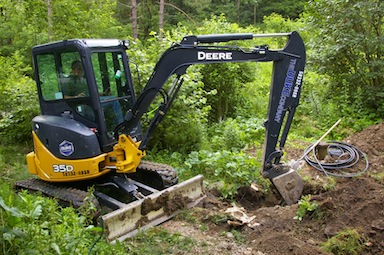
Digging the trench for water and power.
They did an excellent job working around our plants, though we still (of course) lost a few leeks and strawberries on the edges. Digging a trench below the frost line required a wider space than I would have guessed, but it was obvious once the dirt started moving why. The backhoe made short work of the duck pond at the very back of our house property.
A smaller machine, a Bobcat Mini Track Loader, helped them bring in gravel and fill in trenches with less impact than the larger backhoe. (Whitmore Fence had used something similar to dig post holes for our fence.)
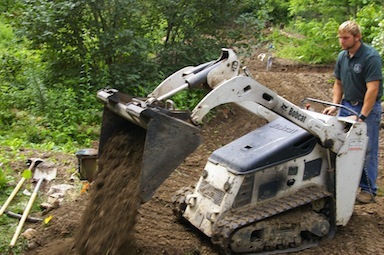
Ethan fills in the trench with the Mini Track Loader.
Right now, the main obvious change is the water hydrants. They provide garden water - from our well, not the Bolton Point water that serves the house - all the way to the edge of the woods behind the house. One is next to the existing shed, while the other two are in the pads for the new sheds, and will provide service inside of them. All of them are frost-free hydrants.
There was one glitch. The hydrants worked, but only when the water on one of the garden faucets on the house was turned on. Otherwise, nothing happened. Duane Scott called Randolph Well & Pump, who'd installed this well long ago, and confirmed that there was an extra one-way valve in the pressure switch. He took out the valve, and everything works well now. (The well pump is also protected from burnout by an electric switch system Randolph put in years ago, so we shoudn't be endangering our pump.)
Now it's our turn. We'll be adding straw to reduce erosion while plants come in. We're starting to lay out a path up the hill and garden beds around it - wide enough to get equipment and things through, but much less than a road. I'll be fencing the duck pond sometime before winter, hopefully when it's cooler. I'm planning to build the first of the sheds, the bigger one, next year. We need to have an electrician come to do the connection to the existing shed sometime as well.
If you'd like to see (a lot) more, I've posted a gallery of pictures of the backyard change.
June 22, 2012
Woodstove, Part II
The earlier work on my woodstove installation mostly involved creating a path to the chimney from the livingroom. The next round of work was more of an upgrade, adding a stainless steel liner to the chimney and installing a top cap at the top and insulated pipe at the bottom.
The stainless steel liner was a last-minute addition to the project, not part of the original plan. I had my doubts about the need for it, but it seems that the extra angle involved because the chimney isn't centered on the wall space where the stove will go made it a more useful idea. I still have to figure out how this will work with cleaning, and will report back more as I get there.
The actual liner is a heavy-duty pipe that looks like an oversized laundry dryer duct, but is much much stronger.
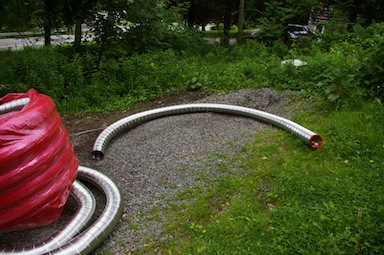
Piece of stainless steel chimney liner.
Once again, Jared and Jesse from Holy Smoke came by to do the installation. This time involved a lot more ladder work, as they had to insert the liner from the top and install a new chimney cap on the top. (I kept the old cap, which I'll move to the other unused chimney, once I find a way to get to the top. That one reaches three stories plus off the ground!)
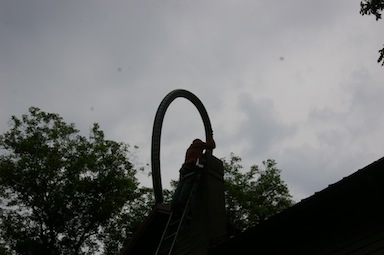
Putting the liner in the chimney.
On the inside of the house, Jared had to assemble an insulated connector pipe with the T fixture at the bottom of the liner, and then put the thimble together.
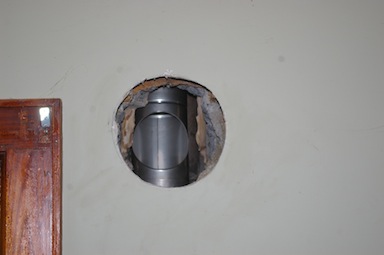
T connection, seen from inside the house..
That finishes the chimney infrastructure. The next step is getting the hearth installed, which is complicated by location and flooring. We're still waiting on the running hot water piece for the stove as well, so this won't be a speedy installation. That needs to go on the back of the stove before we put it in place. It may be a while before my next installment.
Again, I've posted a gallery of photos of the liner installation, if you want to see more of how this was done.
A bit of jealousy for friends with geothermal systems
While I'm upgrading heat sources and tearing up the back yard, I'm also cursing the heat. Friends of mine who tore up their yards and upgraded their heating systems to geothermal, instead of (or in addition to) a woodstove, are enjoying the benefits of air conditioning this week.
I asked about geothermal years ago when we upgraded the furnace and insulated the house, but at that point those folks weren't recommending the extra cost and complication of a geothermal system when natural gas was available, and the amount of land we had for a possible system was marginal. (You either have to put in a lot of wells or dig large horizontal trenches.)
Now, of course, we've planted all that land with things we don't want to disrupt, so we're not going to do even more digging than we've done in any case. So no air conditioning! Oh well.
"Will be done shortly"
Perhaps not long now until we find out what the Department of Environmental Conservation will do with their flawed SGEIS:
"We don't have a hard date, but it will be done shortly," Cuomo said on Albany's 1300-AM (WGDJ)....
"I think it's actually better that we do it when the Legislature is not here, because I don't want a political discussion."
We'll see. I do wonder if this:
"This is the classic balance of the state's role versus local government's role versus federal," Cuomo said. "And many times the state takes the position of, 'Thank you federal government for your opinion, but we're going to do it our way.' Many times a town or a city will say, 'That's nice, I'm glad you think that Albany, but stick to Albany, we know better. Government closest to home knows the best.' "
Is a signal that he's planning to include the home rule provisions suggested by last week's trial balloon leak. Maybe, maybe not.
June 23, 2012
Straw improves the view, reduces erosion
I was happy with the work in our backyard, but all that exposed (if compacted) soil had the potential of rolling down the hill in a major rainstorm. Today I took care of that with four bales of straw.
It turns out that when a project requires adding chaos, like spreading straw, a 2-year-old and a 4-year-old can be very very helpful!
Next up there: seeding with grass in some places and clover in the rest.
Free train rides at Finger Lakes Live Steamers
I'd heard of Finger Lakes Live Steamers, but I don't get up to Clyde very often. Fortunately, Konrad's best friend Benjamin had his second birthday today, so we went up for a party.
it was amazing, pretty much paradise for kids and for anyone with an interest in trains.
It was well worth the hour drive, I suspect worth it even if you don't have kids. They have lots of different trains, all of them worth watching. I'm pretty sure we'll be back.
The next free train ride opportunity is tomorrow, June 24th, from 10:00am to 4:00pm but they'll be doing this again September 22nd and 23rd.
Want (a lot) more? I've posted a gallery of pictures from today's trip.
June 25, 2012
Freeville motorocycle accident leads to airlift
This doesn't sound good:
A Freeville man was seriously injured when his motorcycle failed to make a jump at a private track on Friday in the Town of Dryden....
He was airlifted from the scene by Mercy Flight Helicopter to University Hospital in Syracuse where he was admitted with serious injuries.
June 26, 2012
Democrats and Republicans can vote today
Both registered Democrats and registered Republicans (but no one else) can vote in primary elections today in Dryden.
Democrats have a Congressional primary between Leslie Danks-Burke, Melissa Dobson, and Nate Shinagawa. The winner will go on to face incumbent Tom Reed in November.
Democrats have a Senatorial primary between George Maragos, Bob Turner, and Wendy Long. The winner will go on to face incumbent Kirsten Gillibrand in November.
Polls will be open today from noon to 9:00pm. Remember, as always, that you can't campaign inside of the polling places, and that this includes things like T-shirts, signs, and buttons in addition to trying to actively convert everyone around you.
Everyone is now on the new machines, paper with an electronic scanner.
Depending on which district you live in - see the district map (597KB PDF) - you can vote at:
- Etna Fire Station - 26 Wood Road, Etna (map).
- Freeville Fire Station - 21 Union Street, Freeville (map).
- Dryden Fire Station - 26 North Street, Dryden (map).
- Varna Community Center - 943 Dryden Road, Varna (map).
- Etna Fire Station - 26 Wood Road, Etna (map).
- Dryden Fire Station - 26 North Street, Dryden (map).
- Dryden Fire Station - 26 North Street, Dryden (map).
- Bethel Grove Church Activity Center - 1749 Slaterville Road, Bethel Grove (map).
- Varna Community Center - 943 Dryden Road, Varna (map).
- Reach Out for Christ Church - 318 Johnson Road, Freeville (map).
- Dryden Fire Station - 26 North Street, Dryden (map).
If you'd like to see a sample ballot before going in, the Board of Elections has one for Democrats (PDF) and one for Republicans (PDF).
June 27, 2012
Sounds like a Shinagawa win
The Tompkins County Board of Elections reports unofficially that Nathan Shinagawa won the Democratic Congressional primary here in Tompkins County by a little more than a 3-2 margin, and it sounds like the rest of the 23rd Congressional District went the same way.
Shinagawa will be challenging Republican first-term incumbent Tom Reed this November. If you'd like to know more about the newly-created 23rd District, I've written up an introduction.
Update: Our previous Congressman, Richard Hanna, defeated his Republican primary opponent by more than a 2-to-1 margin, but the challenger may still consider an independent run. Hanna (and possibly Kicinski) will face Democratic challenger Dan Lamb, of Dryden, in November.
Dryden Town Talk reports historian award
Cathy Wakeman's Dryden Town Talk reports that Dryden village historian Elsie Gutchess received the 2012 Franklin D. Roosevelt Local Government Historian Professional Achievement Award (along with Groton historian Rosemarie Tucker) from the Association of Public Historians of New York State April 23rd.
Congratulations, Elsie, and thanks for the help on my weather talk earlier this year!
Wakeman also notes Butterflies and Bugs this Saturday, the Southworth Library's summer reading program and Tremendous Tuesday summer family programs, Music in the Hollow, and tonight's Town Board public hearing on zoning.
June 28, 2012
No rush for drilling
At the bottom of a Corning Leader article about a protest at Talisman Energy's offices in Big Flats, I find this tidbit:
Talisman currently has about 300 Marcellus Shale gas wells in Pennsylvania, but regardless of the fracking debate in New York, the company isn't in a rush to drill here, he said.
"Although we do have land leased in New York State, with the price of gas the way it is, we have enough land in Pennsylvania to keep us busy for a long time, so we don't necessarily have any plans at this point to go work in New York State," Tompkins said. [emphasis added]
I can't say that price will stay that low forever, but I do hope that people who want drilling to happen yesterday realize that the economics - even without disastrous side effects - are terrible at the moment.
If there was ever a good time to pause the conversation and sort through whether this is a good idea in the first place, it's now.
Update: When Exxon says it's losing it's shirt... though this article suggests that some companies are indeed interested.
Update again: And this suggests softness even in the natural gas liquids market. It's going to be a complicated time for gas drillers, whatever New York State may do. How that will affect us, I'm not sure.
And again: Here's what it sounds like when that decline in prices reduces drilling in places that had it. We haven't had the boom, but we haven't had the bust either. (And the bust will come eventually, regardless.)
